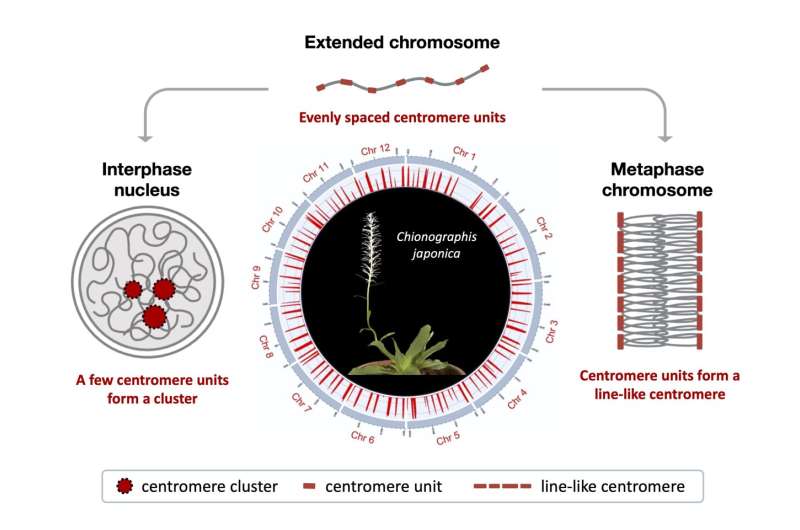This article has been reviewed according to Science X's editorial process and policies. Editors have highlighted the following attributes while ensuring the content's credibility:
fact-checked
peer-reviewed publication
proofread
Centromere plasticity and diversity: Researchers identify a novel type of centromere organization

Holocentric chromosomes have evolved independently from X-shaped monocentric chromosomes multiple times in both animals and plants, but the mechanism behind the centromere-type transition is unknown. Now, an international research team has assembled the chromosome-scale reference genome and analyzed the holocentromere organization of the lilioid Chionographis japonica.
Remarkably, the holocentromere consists of only 7 to 11 evenly spaced megabase-sized centromere units from telomere to telomere. The size of single centromere units in this plant species is comparable to those in monocentric species and is ~200-fold larger than those of other holocentric plants. "Such a small number of centromere units, but so large, has not yet been demonstrated in any animal or plant organism," says Dr. Yi-Tzu Kuo, the first author of this study.
The evenly spaced centromere units might be a prerequisite for forming cylindrically-shaped metaphase chromosomes with line-like sister holocentromeres facing opposite poles. During mitotic chromosome condensation, looping and folding of chromatin bring the megabase-sized centromere units along the chromatid close to each other into a line-like holocentromere to function like a single centromere.
"This makes the chromosome more stable and robust, because otherwise, it would be torn apart during cell division," explains Prof. Dr. Andreas Houben, head of IPK's research group "Chromosome Structure and Function."
Unlike all the known holocentric genomes possessing uniformly mixed eu- and heterochromatin, in C. japonica, both epigenetically defined chromatin types are organized into distinct domains like in many monocentric species. Gene-active and gene-inactive areas are thus spatially separated from each other.
"The study broadens our knowledge about centromere plasticity and diversity, and also demonstrates the unique value of exploring non-model species for evolutionary comparison to reveal novelties in even well-studied structures like the centromere," says Dr. Yi-Tzu Kuo.
The work is published in the journal Nature Communications.
More information: Yi-Tzu Kuo et al, Holocentromeres can consist of merely a few megabase-sized satellite arrays, Nature Communications (2023). DOI: 10.1038/s41467-023-38922-7
Journal information: Nature Communications
Provided by Leibniz Institute of Plant Genetics and Crop Plant Research





















